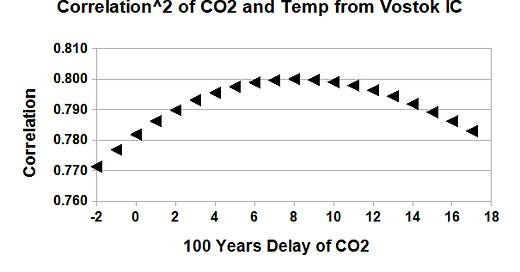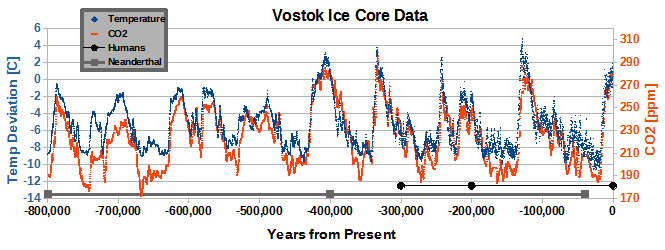The Earth has been cooling since it was first formed about 4 - 5 billion years ago. It has cooled from a high temperature vapor, then condensing into to a liquid (molten rock and iron), and finally cooling enough to have a solid crust on the surface now about 10 miles thick (compared to the Earth’s radius of about 4000 miles). About 3 or 4 million years ago the Earth had cooled so much that it entered into a period of glaciation. Which brings us almost to today and the Vostok Ice Cores.
In 1980 the Soviets began drilling a series of ice cores in the ice above Lake Vostok in Antarctica. At times they worked year round with temperatures as low as - 70 C (-94 F). Work continued through the end of 1998 when the 5G core reached a depth of 3623 meters (2.25 miles) just above the surface of Lake Vostok. This last ice core provided a climate record going back 800,000 years in time. Why they did not get a Nobel Prize for this work I don’t know; perhaps the Nobel Committee couldn’t figure out whether the Prize should be for Physics, Chemistry, Engineering, or Archaeology or all of the above or even more of these. Or maybe because they were Russian, who knows. There’s of course no politics in Science or Nobel’s (Sarcasm).
Figure 1 shows a record of the Earth’s Temperature and CO2 atmospheric concentration from the Vostok Ice Core for the last 800,000, or 0.8 million, years. (Mud core data go back even further in time, about 5 million years, and shows the onset of Glaciation about 3 million years ago).
Figure 1. Vostok Ice core data showing Temperature and Atmospheric CO2 concentration for the past 800,000 years. Also shown are the approximate time that Humans and Neanderthal Man have been walking around on the Earth. Each data point represents a 100 year average of the Earth’s temperature. (This spans about 0.02% of the Earth’s history — so maybe this isn’t “climate” data, but rather “recent weather” data).
A few observations:
The Earth’s present “Climate” seems to be that most (80 - 90%) of the time we live in Ice Ages with brief “Inter-Glacial” periods when the ice retreats and the world warms up. The present inter-glacial period that we are living in today is called the Holocene (don’t worry, there won’t be a test). During the Ice Ages the Earth’s temperature can be 24 degrees F colder than in Inter-Glacial periods (e.g., today). The last ice age “ended” about 15,000 years ago. I live in Southern Indiana where it is very hilly, even rugged. That’s because merely 15,000 years ago ice was literally over a mile thick from about 20 - 30 miles North of where I live all the way to the north pole. The beautiful hills of Brown County, where they pump the sunshine in and the moonshine out, and the home of Blue Grass music, are believed to be caused by all the run-off as these glaciers melted. North of here, where the glaciers sat, it is flatter than piss in a platter. That’s where Humans today grow corn and soy beans and buffalo (and bear and wolf and panther) no longer roam. During this melting of the glaciers the sea level rose by about 120 meters (400 ft) and the sea level is still rising today by about 1 inch per year and probably will continue to do so until the next Ice Age begins).
Humans have lived through 2 or 3 Ice Ages, and Neanderthal Man maybe as many as 4 to 8 of them (of course these creatures weren’t living in the Northern regions, as least during the Ice Ages !). My guess is that Neanderthal Man was exterminated by Humans, just as the wolf has almost been exterminated by Humans. But most Humans today have Neanderthal genes in their genomes ! So, there was some inter-breeding before we exterminated them.
The temperature in this present inter-glacial period is about 2 or 3 degrees Celsius or Kelvin (4 to 6 degrees Fahrenheit) colder than during that last brief inter-glacial period.
The present inter-glacial period has already lasted longer than the previous inter-glacial period. My modeling using the Milankovich Cycles predicts the onset of the next Ice Age sometime in the next few thousand years, give or take a few thousand years.
Well, maybe one other interesting observation from Figure 1 is that the Earth’s Temperature and the Atmospheric CO2 concentration seem to be pretty highly correlated. It turns out that I’m not the first person to notice this (of course neglecting the authors of these data who made these measurements and published their findings). Most notably a politician named Al Gore later first-noticed this correlation, and made this plot famous. There is even a movie about it and he even won a Nobel Prize for his astute observation.
In the movie Gore shows this plot and says something like, “You don’t need a Ph.D. in Physics to see that Temperature and CO2 are correlated”. And that is very true. Gore then goes on to claim that therefore CO2 determines Temperature. What is also true is that you don’t need a Ph.D. in Physics to download these data into a Spreadsheet (I use free open source Libre Calc) to evaluate the degree of correlation, as shown in Figure 2.
Figure 2. R-squared, or the Correlation function squared, versus delay between Temperature and CO2 using the Vostok Ice Core Data.
QA/QC (Quality Assurance/Quality Control) engineers either love, or love to hate, R-squared values. Simply, R-squared tells you how much of the variation of the dependent variable is due to variation of the independent variable. Mr. Gore must have never done this calculation — because he would like you to believe that CO2 is the independent variable and Temperature is the dependent variable, i.e., that CO2 determines Temperature. The DATA show that CO2 changes are DUE TO or BECAUSE OF or CAUSED BY changes in Temperature, and that CO2 lags temperature by about 800 years (on average, more on this later) and that 80% of the variation in CO2 is caused by variation in the Earths’s Temperature. (And, again, you don’t need a Ph.D. in Physics to understand that CAUSE comes before EFFECT, unless you want to get into some REALLY weird physics where you would definitely need a Ph.D. and maybe some really good drugs).
But an “800 year delay” of CO2 vs Temperature doesn’t really tell the whole story. Let’s look in detail at the last two Inter-Glacial Periods as shown in Fig. 3. Or maybe I’ll just stop here and pick it up again tomorrow or the next day in “Anthropogenic Global Warming III” — stay tuned !





What source did you get the vostok ice core data from? I seem to be able to find only smoothed data, which doesn't show as much variation as you do here